Introduction
Only fifteen years ago, the average middle-class Indian consumer had to physically visit their grocer at the start of the month to stock the essentials. Amongst them, the more enterprising grocer would offer a revolutionary service, home delivery, and sometimes, if the billed amount was high enough – it would be free.
The home delivery option was the height of innovation in retail for most Indian families. Fast forward a decade and a half, and today, we have retailers jousting with each other to eke out an extra second of attention both offline and online.
In this article, we will look at some of the retail trends to look out for in 2024.
Report Summary
India’s retail sector contributes to 10% of the GDP of the nearly $3.7 trillion economy, this sector has the potential to reach a valuation of $2 trillion by the end of 2032.
These numbers cannot be conceptualized without a frame of reference. India’s retail sector alone would be the 11th largest economy in the world today above nations like Russia, South Korea, Australia, and Spain among others.
This sector also accounts for the employment of 8% of India’s working population or 35 million people in numbers. And, this industry is expected to add another 25 million new jobs by the end of 2030.
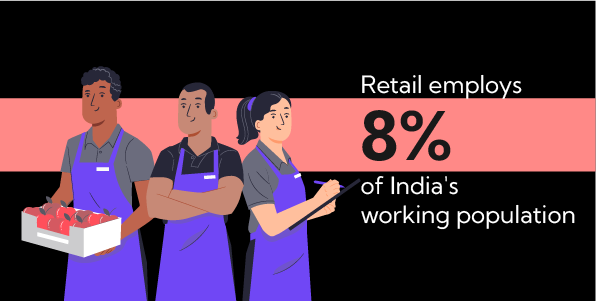
The retail sector in India is poised for explosive growth due to the following reasons.
- Increasing spending potential of the Indian middle class
- Urbanization (Expansion of Coimbatore, Nagpur, Lucknow, Patna, etc)
- Increasing mobile network penetration. (77% of Indians now have a mobile connection)
- The spending capacity of the GenZ and Millenial cohort
- Application of new technologies in retail
This report aims to uncover upcoming trends in the 2024 retail landscape, driven by shifting consumer habits and influenced by technological advancements. We hope that this report empowers readers with a comprehensive understanding of the Indian retail industry in 2024, empowering business leaders, expansion heads, researchers, and retail students to strategize effectively.
Retail Trend 1: Omnichannel Retail
Retailers adopting omnichannel strategies integrate multiple channels to optimize customer interaction across all touch points. From the first interaction, through the discovery, to developing the buying intent, and finally, the purchase, an omnichannel retailer provides an effortless buying experience.
For example, the marketing team of a D2C brand can leverage the inferences about the customer’s shopping experience to provide product recommendations that meet their requirements. The brand can redirect customers to their retail stores to experience the product first-hand, like in the case of Pepperfry, which has witnessed a 45% increase in conversion rate by implementing an omnichannel strategy.
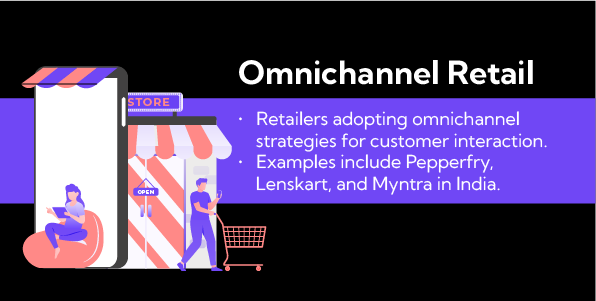
In India, Pepperfry, Lenskart, and Myntra are the major brands employing an omnichannel strategy to build an efficient inventory management tool, reduce data optimization costs, and for cost-effective marketing purposes.
Adopting an omnichannel retail strategy ensures that customers develop loyalty toward the brand, leading to an increase in foot traffic, increasing profitability, and better customer engagement.
Retailers in 2024 will strike a fine balance between physical stores and the online experience to create an environment where customers will enjoy a seamless shopping experience.
Retail Trend 2 : GenZ and Millenials
Millennials and Gen Z buy into the brand’s story and display brand loyalty more than their preceding generations. With over 60% of GenZ agreeing that the brands they choose are an extension of their individuality, brands have to position themselves to stand out from the crowd.

The new generation of consumers also crave novelty from the products that they purchase. For example, Newme, an omnichannel chain, releases new design drops every few weeks to maintain the freshness of its offerings. This trend is poised to persist in 2024 as brands evolve to deliver tailored and individualized shopping experiences to a consumer base that seeks to stand out from the crowd.
Retail Trends 3: Influencer Marketing Trends in 2024
72% of all millennials and GenZ users worldwide follow an influencer. Influencer marketing is an evolving domain where the meta has changed from the number of followers to niche influencers who have built a community around them. Today, the onus is on telling relatable real-life stories; brands can leverage this genuine interaction between influencers and audiences to advance their products.
Influencer marketing can also be as simple as getting a celebrity to endorse your product like boAt did with Karthik Aaryan. Or, it could involve brands utilizing employee-generated content to raise brand visibility.
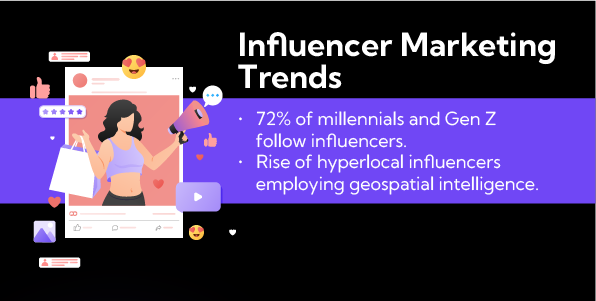
The authenticity and trust indicators of EGC have led to over 89% of C-Suite executives in India attesting to the relevance of employee influencer marketing in 2024.
In 2024, brands will shift to long-term collaborations with influencers allowing them to increase their credibility and improve brand loyalty. Influencers will also start to become more hyperlocal with brands employing geospatial intelligence to target creators who are large in specific vernacular niches.
Retail Trends 4: Scarcity is Demand
Retail strategy is a lesson in human psychology, turning up surprises at every turn. For instance, conventional wisdom dictates that empty shelves will result in lost business opportunities. The IHL group released a report that mentions a loss of $1.2 trillion arising because of lost sale opportunities, not to mention the loss of customer confidence and loyalty.
But, if that were the case, why do brands like Nike, Starbucks, and Prime employ strategies where specific items are available only for a limited time?
People have an intrinsic tendency to associate sold-out with high-quality products. Therefore, when a famous brand announces its product is sold out, instead of losing brand loyalty, it creates a unique value proposition where scarcity is demand.
Consider the example of Prime launched by two YouTubers, Jake Paul and KSI. To market their energy drink, they advertised it on both channels and asked their fans to demand SKUs in their nearest retailers. And it was a masterclass in harnessing the latent potential of a fan base. Today, Prime energy drinks have generated annual sales of $1.2 billion in 2023 alone, making it the fastest-growing beverage in the history of the world.
In 2024, the data collected from allied technologies connected to retail shops will assist in the release of hyper-personalized and limited-edition products. Brands will position these products as having a reduced supply due to increased demand.
Retail Trends 5: The Halo Effect of Brick-and-Mortar Stores
A few years ago, the rage in the retail business was the dominance of online-only retail stores. But, the ground reality today is that online-only stores are not profitable. Multi-faceted reasons make e-commerce retail stores unprofitable.
- Returns: Online apparel retail stores generally see a 50% return on most items. The eCommerce retailer will then have to factor in additional man-hours to repack the item, process the article, and send it back to the manufacturer (in case of an aggregator)/ primary producer, all of which reduce the operation’s profitability.
- Fulfillment centers: Today, the consumer expects same-day delivery or 2-3 business days at the latest. This requires a robust logistic network with multiple delivery partners that have to work like clockwork, all facilitated by expensive fulfillment centers.
However, brick-and-mortar stores do not require a special warehouse; they can store the product inside the store itself. It is reported that showcasing your product in-store can boost sales by 110%, and then there is an added advantage for customers who choose the Buy Online Pick Up in Store mode to purchase their goods. This payment mode leads to a 40% increase in sales due to customers who make additional purchases when they come to pick up their orders.
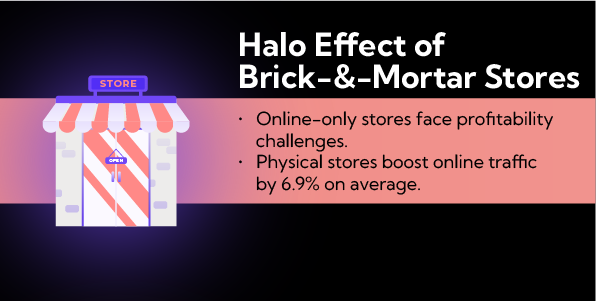
The International Council of Shopping Centers conducted an extensive survey and identified an average increase of 6.9% in a brand’s online traffic after opening a physical store.
This data shows that customers prefer offline shopping over online shopping and highlights the importance of offline stores in expanding omnichannel retail. This metric will see an increase in the building of new brick-and-mortar stores.
Retail Trends 6: Ethical and Sustainable Practices
The current Generation Z, or those born between 1997 and 2012, represents 27% of the total population of India. That is 327 million people for those who were keeping count—an astronomical number that could make or break an entire category.
GenZ’s shopping habits are different from the ones exhibited by the current generation of millennials. As mentioned earlier, this generation requires physical and digital touchpoints before making their final purchase. Given that 81% of Millennials and 79% of GenZ deem climate change significant, they emphasize the brand’s story and its ethical and sustainable practices.

Brands globally have started to adopt these changing preferences in their stride. For example, brands like Sephora and Ult add sustainability tags to their products, allowing consumers to make informed decisions. Global beauty brands like Douglas offer consumer transparency by offering to select cruelty-free, vegan, and organic products.
Closer to home, the fashion brand Neeman’s manufactures shoes made from recycled plastic bottles and uses recycled tires to manufacture slippers.
In 2024, brands will embrace sustainable practices and ensure that their products are ethically sourced. This will include reducing the usage of plastic in the packaging of materials and repurposing cardboard boxes as detailed below. The broader retail community will embrace the creation of a recycling economy, a brand-new avenue for exploring the entrepreneurial spirits of Indians.
Retail Trends 7: Recycling and Resale; the New Meta
What was once shunned by the generations has become vogue due to Gen Z’s single-minded pursuit of discovering a steal while ensuring a negative carbon footprint. Recycling has come a long way from the days of hand-me-downs in the family. Giant multinational fashion retailers have embraced recycling, and for good reason. 54% of GenZs have reported participating in the recycling economy, and a further 97% reported participating in the circular economy without defining it as such.
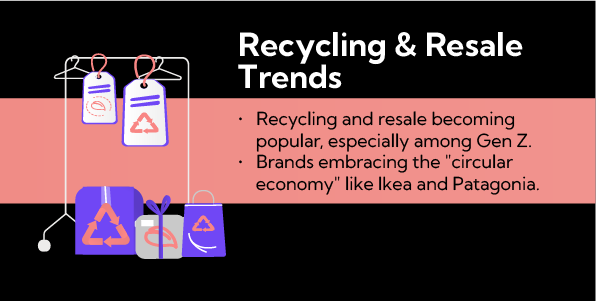
Retailers like Ikea and Patagonia are embracing the changing dynamics of retail to capture the attention of the next generation of consumers. While some retailers consider recycling to generate additional revenue, most existing fashion retailers use reselling and recycling for user acquisition. For instance, M.M.LaFleur launched a resale program and discovered that 24% of the customers were first-time buyers, and 10% would buy a full-price item from the store.
In 2024, brands will embrace the “circular economy” trend, investing in recycling programs that minimize the organization’s carbon footprint and unlock new revenue streams, offering consumers an affordable marketplace for eco-friendly exchanges.
Retail Trends 8: Rise of Value Fashion
Apparel brands nationwide have embraced the considerations of the evolved Indian clientele. Brands that started as purely online retailers are now venturing into the larger world of retail apparel. Brands like Souled Store and WROGN leverage their extensive datasets of the behavior of their target audience to predict locations for expansion accurately. In the case of Souled Store, they have raised ₹135 Crore to fuel their expansion of building 100 new stores nationwide.
There is a good reason behind the bullish outlook from investors in the Indian apparel market for 2024. ICRA has predicted a 10% increase in the capital expenditure cost of retail expansion in the apparel industry, signaling a revival of the demand in the Indian apparel industry.
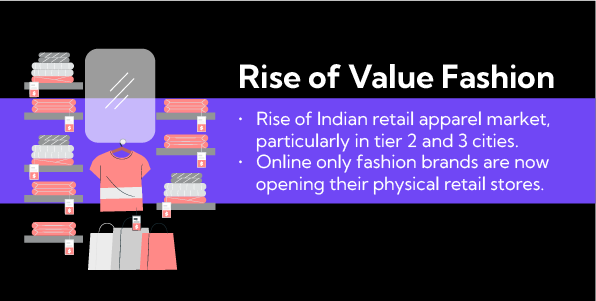
The surge in the Indian retail apparel market is particularly pronounced in the tier 2 and tier 3 cities, with Reliance Retail planning to establish 500 stores. One can witness a radical shift in consumption and spending patterns of small-town consumers as they move beyond necessities and indulge in products and brands that were once available and sold only in urban areas. The rise of the small-town elite also opens doors for luxury brands to enter markets beyond metros.
Meanwhile, Indians report a desire to purchase textiles sourced ethically and have a negative carbon footprint. The reality is that sustainable clothes are 50% more expensive than value fashion retailers’ alternatives. Coupled with increasing inflationary pressures, sustainable options for fashion are increasingly becoming out of reach for the average Indian consumer. This opens the door for fast-fashion retailers to position themselves as the only natural viable alternative to sustainable fashion.
In 2024 the value fashion segment of the Indian apparel industry can expect investments from multi-national organizations like the Chinese fast fashion brand Shien joining a growing list of international and national brands eyeing the lucrative Indian apparel market valued at over ₹ three trillion
Historically a segment dominated by unorganized retail, regional retailers are now seeking to carve their space into this competitive niche. An example is the expansion of the Tata Group-owned Zudio has distilled capturing market share into an exact art. In FY23 alone, the group opened 325 new stores around the country. And location selection forms a vital part of their expansion strategy. The expansion managers focus on choosing low-rental locations on the city’s outskirts, ensuring their apparel production in bulk to reduce the MRP of their offering.
Retail Trends 9: Hyperlocal delivery
It’s late at night, and you feel the pangs of hunger. So, you open your food delivery app to order a hot post-dinner meal and your grocery delivery app to get a cold beverage. And before you have seen the first ten minutes of your movie, your order is delivered to your doorstep.
India has seen a surge in companies promising quick and precise delivery. This includes the market leaders of Zepto, Blinkit, Zomato, and others. And 10 minutes is the Goldilocks zone, which speaks to a brand’s technical and logistical capability.
With a reported market of $45 billion, India’s quick commerce giants are employing the latest technological advancements to reduce delivery time. Retail location analytics is one of the technologies being leveraged to serve the end customer better.
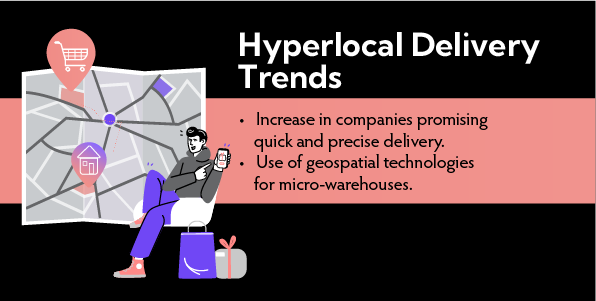
Brands use geospatial technologies to pinpoint locations to construct a micro-warehouse or an urban fulfillment center. These micro-warehouses are smaller than traditional warehouses, and enterprising companies use location data to identify sites that meet the demands and have low rents, making hyperlocal affordable and seamless.
The location data helps the brands lower the delivery time by reducing the distance between the customer and the warehouse.
Companies in verticals other than food and groceries have begun implementing location analytics to build mico-warehouses to facilitate delivery time, including logistics companies like ShadowFax and pharma aggregators like 1MG and PharmEasy.
In 2024, hyper-local delivery chains will invest in upgrading their micro-warehouses to satisfy the growing expectations of consumers who want to reduce delivery time. These chains will leverage the power of machine learning and location analytics to identify the sites where they can build warehouses and cloud kitchens to get ahead of the competition.
Retail Trends 10: Rise of Vernacular Marketing Strategies in 2024
Did you know that only 10% of Indians are comfortable speaking English?
The diverse composition of languages in India requires a concerted marketing strategy to reach the target audience effectively. Brands like Amul and national newspapers already run vernacular content to improve their reach and increase the size of their target market. eCommerce giant Flipkart reports that 20% of new customers have been acquired through vernacular channels.
eCommerce sites like Meesho draw the lion’s share of their customers from tier 4+ cities, where 70% of the population prefers using vernacular language over English. Providing content in the vernacular most familiar to users helps them better understand the product, leading to repeat purchases. Myntra also offers a vernacular search feature to help users precisely identify their requested product. With over 25% of all users in eCommerce using a vernacular voice service for product search at least once in 2022, the following year will see an increase in the adoption of these services.
Pan-Indian retail eCommerce brands are recognizing the advances of using vernacular marketing strategies to build models tailored to the unique needs of the Indian consumer in 2024.
Retail Trends 11: Digital Payments
Some citizens have not used hard currency in a long time or never used their cards (credit or debit). These consumers have only used their mobile wallets linked to their bank accounts for all their transactions. From auto fares to grocery bills, mobile wallets have brought about a revolution in the way Indians spend money. It is no surprise that Indians accounted for 46% of the total global real-time transactions, a number that is only going to increase in the future. In the calendar year 2023, UPI transactions reached $700 billion.
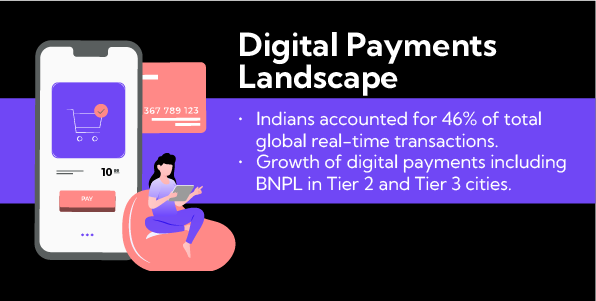
The new clusters of growth for digital payments in India will be in the Tier 2 and Tier 3 cities, generating 60-70% of new clients in the last two years. The pervasiveness of the 5G network in rural India will further increase the number of people in the digital payment ecosystem, with one report suggesting that over 90% of all retail transactions in the future will be carried out through this medium.
Buy Now Pay Later: There has been an explosion in the number of users accessing Buy Now Pay Later services, with over 41% of all respondents in this survey saying that they have used a BNPL service. In India, 22% of consumers have used BNPL services like LazyPay and Simpl to pay for products. LazyPay has grown 400% in the last two years thanks to the adoption of digital payments during the pandemic. These players now target the largely untapped but influential consumers concentrated in India’s Tier 2 and Tier 3 cities.
Advances in UPI payment: The Government of India, in its quest to create a cashless society, has deployed several initiatives to improve the adoption of digital payments in the country; these include:
- UPI 123PAY: Now you can pay your bills with your mobile phone number; this move has onboarded 400 million new users to the platform.
- Geotagging: To understand the market penetration of digital payment, the RBI has issued a framework to record the information on digital payments at the source.
- UPI Lite: Consumers can top-up with their digital wallets with up to ₹2,000 to be used in areas not serviced by a stable internet connection/no internet connection.
Need for Adoption of Digital Payments: The first rule of business is that the customer is king. The second rule is that not all customers are created equal. Nearly 90% of all retail payment transactions in rural India occur through Cash On Delivery. This COD statistic wouldn’t be troubling if not for the fact that one in every three COD orders remains undelivered. Return To Origin is a phrase used to describe the process when the order is not delivered and gets sent back to the warehouse, increasing the overhead of the delivery company.
In 2024, retailers will apply retail location analytics to gauge the probability of COD success at a given location. Retailers can employ location analytics to understand the features of a site by comparing the attributes of similar locations present in the country. The growing penetration of mobile internet will shape the adoption of mobile-enabled payment in retail stores across the country. As more and more internet-enabled citizens in tier II, III, IV, and rural regions adapt to digital payment methods, it will be easier for retail brands to set up businesses in these regions.
Retail Trends 12: The Rise of Phygital Retail
Due to the proliferation of the Internet, as mentioned above, India witnessed an increase of 125 million online shoppers in just the last three years alone. This new generation of shoppers expects a certain level of convenience, from getting the option to pay online and pick up the product at the store, to buying at the store and getting it delivered to their doorstep. Retailers can achieve this ease of customer interaction when they adopt phygital shopping methods. A Phygital retail experience could be as simple as placing an order on the kiosk screen at a local McDonald’s or employing QR codes to help the customer gain additional information about a product.
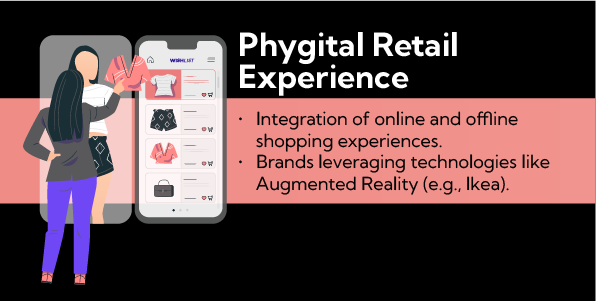
Brands like Ikea are advancing the probability of what is possible with technology by incorporating Augmented Reality into their mobile application. Shoppers can choose a product from the Ikea catalog on their app, which scales the product and places it inside their room with an accuracy of 98%.
In 2024, brands will leverage technological advances to increase the ease of shopping experience for their customers where they can seamlessly shift between online and offline.
Retail Trends 13: Social Commerce
The advent of social media has revolutionized the way we interact with each other. A brand new way of talking to each other necessitated a need for the evolution of traditional business models.
The social commerce industry in India will reach $1.9 billion by the end of 2028. This industry’s productivity explosion is due to the greater penetration of wireless mobile networks nationwide.

User-Generated Content: The content derived from real user interaction with the product or service. Consider the reviews of movies and restaurants that populate our feeds; that is an example of UGC. With over 84% of all consumers trusting peer recommendations over other advertising sources, 2024 will witness brands using peer reviews to boost their credibility.
The Social Shopping Network: Facebook marketplace democratized the online shopping experience, bringing sellers and buyers from around the country under a single roof. Buoyed by the success enjoyed by the Facebook marketplace, Shopsy, Bulbul, and DealShare have started to target Indians by offering services in different vernaculars.
Interactive shopping experience: Imagine walking up to a display screen, and it shows you the different choices available for your skin tone.
This is an example of the interactive display offered by Sephora, where they analyze the user’s requirements in real-time and provide tailor-made solutions that suit each customer’s preference. Retailers could also take a leaf out of the game plan of most automotive dealers and let the customer interact with the product before they make a purchase.
In 2024, brands will start to adopt interactive shopping experiences on a large scale. Consumers will get to choose from a variety of payment options, from BNPL to pay online pickup in-store. There will be a transformation in the way influencers interact with consumers as mentioned above, influencers will create shopping guides rather than sellers of a product.
Retail Trends 14: Data Security and Privacy
Retail is a commerce sector that thrives based on the quantum of accessible data. From plotting user personas to create a better user experience to ensuring that stocks are continuously updated, data enables the smooth functioning of modern retail. Both physical, eCommerce, and omnichannel retail use data to better understand customer and marketing efforts.
This is the reason why retailers have to face the worst ransomware attacks. Even as recently as December of 2023, the parent companies of Vans, Timberland, and Northface, were hit by a ransomware attack. The attack encrypted sensitive personal data, disrupting the business activities of the subsidiary companies.
Closer to home, business executives are worried about the 278% increase in ransomware attacks directed toward India over the last two years from 2021-2023. In fact, in November 2022, the servers of the AIIMS were hacked, rendering it impossible for the AIIMS staff to use their services.
According to the Sophos survey, the state of ransomware in retail found that only 26% of retailers could stop ransomware attackers from breaching their defenses. With over 43% of retail victims paying the ransom, retailers are a veritable treasure trove for the perpetrators of ransomware attacks. However, the percentage of businesses that recovered and returned to routine practices increased from 17% last year to 21% this year. This signals the increase in the sophistication of the ransomware attacks and the encryption employed by the hackers.

The same report also defined the primary reasons behind the increase in ransomware attacks; these include:
- Exploited Vulnerability (as in the case of the coWIN hack)
- Compromised Credentials
- Email Phishing Attacks
To protect users’ data, companies and government agencies are adopting a two-pronged strategy, with best practices, sweeping legislations, and court rulings enforcing the right of privacy awarded to users worldwide.
Governments worldwide have also taken cognizance of the increasing data vulnerabilities of the general public. Successive legislation from the General Data Protection Regulation of the European Union, the California Consumer Privacy Act (CCPA) of the United States, and the Digital Personal Data Protection Bill of India ensure the protection of the cybersecurity capabilities of retailers in these countries.
Best Practices for Data Security in 2024
- Security as a solution: Businesses outsource their cybersecurity defenses to a third-party agency (a Managed Detection and response provider) providing real-time security analysis and protection against threats. These services are staffed by professionals who can spot positive and negative threats. They can minimize the damage wrought by denials of service attacks, malware, and social engineering, among others.
- Zero Trust Network Access: The trust has no one mode of security. The loss due to compromised credentials of an employee can be drastically reduced by limiting their access to only specific parts of the network necessary for their daily operations. The user gets access after the ZTNA authenticates the user’s request.
- Security Info and Event Management (SIEM): If the MDR mentioned above mitigates the risk in real-time. SIEM tools help organizations analyze the threat to develop contingency plans against future attacks. Utilizing the three best practices will ensure that even though India is among the worst-hit countries due to ransomware, they can protect their data.
Conclusion
In the dynamic landscape of Indian retail poised for unprecedented growth, 2024 heralds a transformative era. As the sector burgeons to potentially become the 11th largest economy globally, a nexus of factors, from omnichannel strategies and influencer marketing to digital payments and the rise of vernacular dynamics, will steer its trajectory. The industry-wide adoption of omnichannel retail and the fortification of data security underscores the pivotal role technology plays, one such technology can be found at GeoIQ providing each type of location data intelligence and much more. A nuanced understanding of these trends equips stakeholders to navigate the complexities, ensuring resilience and relevance in the ever-evolving realm of Indian retail.


